
Germantown Grammar School, also known as Lafayette Grammar School and Opportunities Industrial Center, Inc., are two historic school buildings located in the Germantown neighborhood of Philadelphia, Pennsylvania. Germantown Grammar School #1 was built in 1874–1875, and is a three-story, serpentine brownstone building in a combined Italianate / Gothic-style. It has a two-story addition dated to the 1980s. It features dressed brownstone trim; a projecting, pedimented front section; and projecting cross-gables. Germantown Grammar School #2 was built in 1886-1887, and is a two-story, four bay by nine bay, brick building faced in Wissahickon schist in a vernacular Italianate-style.
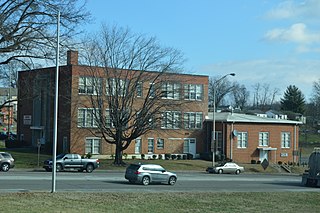
Douglass School is a historic school building for African-American children in Bristol, Virginia. The original section was built in 1921, with additions and alterations from about 1929 and 1963. It is a two-story, three-bay brick building with a flat roof.

Powell's Tavern is a historic inn and tavern located at Manakin, Goochland County, Virginia. The earliest section was built about 1808, with additions made by 1815 and 1820. It is a two-story, "H"-shaped brick and frame building. The original section is a two-story frame block with a gable roof and two low one-story wings with shed roofs. It is connected to the later two-story, five-bay brick section by a two-story hyphen added in 1958.

Red Lane Tavern is a historic inn and tavern located at Powhatan, Powhatan County, Virginia. It was built in 1832, and is a 1 1/2-story, log building set on a brick foundation. The main block has a gable roof and exterior end chimneys. It has a 1 1/2-story kitchen connect to the main block by a one-story addition. The building housed an ordinary from 1836 to 1845. It is representative of a Tidewater South folk house.

Belle–Hampton, also known as Hayfield, is a historic home located near Dublin, Pulaski County, Virginia. It is a two-story, brick dwelling that consists of two sections. The original section was built about 1826, and is the two-story, three room rear section, with a large two-story two-room addition built about 1879, and obscuring the original front. The house exhibits Federal and Italianate style decorative elements. Among the contributing buildings and structures are a 1931 swimming pool and tennis court; a probable kitchen/ washhouse / slave dwelling, barn, granary, and a meathouse that date to the 19th century. The property also includes the site of a private coal-mining operation with a well-preserved commissary building and blacksmith shop. The property was the home, farm and industrial operation of James Hoge Tyler, industrialist, agricultural and industrial promoter, and governor of Virginia from 1898 to 1902.

Montebello is a historic home located at Charlottesville, Virginia. The central section was built in 1819-1820, and consists of three-part facade, with a three bay, two-story central block with single-story flanking wings. The original section has a single pile, brick I-house plan with a central hall flanked by a room on each side. Also on the property is a contributing 1 1/2-story, brick, two-car garage. The house was built by John M. Perry, one of the workmen who worked with Thomas Jefferson at Monticello and on his many building projects at the University of Virginia. The University of Virginia purchased the house and property in 1963 and it currently serves as a residence for faculty.
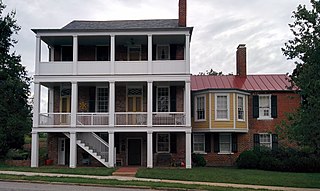
The Rowe House is a historic home located at Fredericksburg, Virginia. It was built in 1828, and is a two-story, four-bay, double-pile, side-passage-plan Federal style brick dwelling. It has an English basement, molded brick cornice, deep gable roof, and two-story front porch. Attached to the house is a one-story, brick, two-room addition, also with a raised basement, and a one-story, late 19th century frame wing. The interior features Greek Revival-style pattern mouldings. Also on the property is a garden storage building built in about 1950, that was designed to resemble a 19th-century smokehouse.
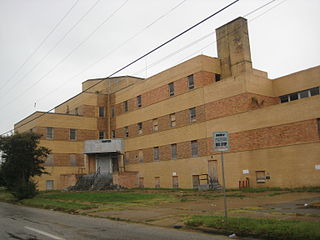
Whittaker Memorial Hospital is a historic hospital building located in the Brookville Heights neighborhood in the East End of Newport News, Virginia. The original section was built in 1943 with additions in 1957 and 1966. The earliest portion of the building has a symmetrical "T"-plan with both Moderne and Art Deco influences. It has a concrete frame, with concrete roof and floor slabs, and curtain walls constructed of alternating bands of yellow and brown bricks. The central mass is three stories tall and has two-story wings. The Whittaker Memorial Hospital was founded in 1908 to serve the African-American population of Newport News. The hospital was built by African-American physicians and designed by African-American architects. It was originally housed in the James A. Fields House, then in a frame hospital built in 1915 before this building was constructed in 1943. The hospital closed in 1985.

American Cigar Company are two historic cigar factory buildings located at Norfolk, Virginia. The buildings were built about 1903 and consist of a stemmery and the boiler room. Albert F. Huntt is credited as the architect. The American Cigar Co. was created in 1901 as a subsidiary of the American Tobacco Company. It was listed on the National Register of Historic Places in 2009.
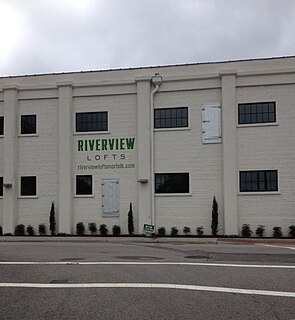
Virginia Ice & Freezing Corporation Cold Storage Warehouse is a historic cold-storage warehouse building located at Norfolk, Virginia, United States. It was built in 1920, and is a three-story concrete block building on a concrete foundation, built in three sections. The sections are a two-story, eight-bay warehouse; a three-story, L-shaped addition; and a two-story concrete block addition. The Virginia Ice & Freezing Corp. had one of the largest ice and cold storage operations in Norfolk and was located next to several of the leading oyster and fish processing plants.
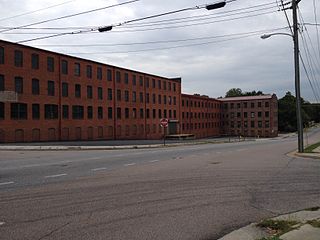
Virginia Trunk & Bag Company is a historic factory complex located at Petersburg, Virginia. It was constructed in several phases between 1903 and about 1931. The two contributing buildings are the trunk factory building (1903) and storage and shipping building (1903). The two buildings are connected by two enclosed pedestrian bridges. The trunk factory is a four-story brick building with a number of additions. The storage and shipping building is a three- and four-story brick building. The railroad spur is a contributing site.

The West Broad Street Commercial Historic District is a national historic district located at Richmond, Virginia. The district encompasses 20 contributing buildings built between about 1900 and the late 1930s. Located in the district is the Forbes Motor Car Company (1919), Harper-Overland Company building (1921), Firestone Building (1929), Engine Company No. 10 Firehouse, and the Saunders Station Post Office (1937). The majority of the buildings are two-to-four stories in height and are composed of brick with stucco, stone and metal detailing. Located in the district is the separately listed The Coliseum-Duplex Envelope Company Building.

Crenshaw House, also known as Younger House and Clay House, is a historic home located in Richmond, Virginia. It was built in 1891, and is a three-story, Victorian Italianate style brick townhouse. The house was altered by the architectural firm of Noland and Baskervill in 1904. It features a flat roof decorated with a Doric entablature and copper cresting, a full height three-sided bay window, and an entry porch supported by paired Doric order columns. At two meetings in November 1909, a group of women met at the home to form what would become the Equal Suffrage League of Virginia (ESL).

St. Andrew's Church is an historic Episcopal church complex in Richmond, Virginia, United States. The complex consists of the church (1901), school (1901), parish hall (1904), Instructive Nurse Association Building (1904), and William Byrd Community House or Arents Free Library (1908). The church is a rough-faced Virginia granite, cruciform Gothic Revival style structure dominated by a 115-foot corner tower. The school and parish hall are three-story, brick buildings on a stone basements.

Hasker and Marcuse Factory, originally part of the American Can Company, is a historic factory building located in Richmond, Virginia. The original section was built in 1893 and expanded through 1915. It is a four- to five-story, brick industrial building. The factory housed manufacturers of printed, polychromatic tin boxes and tin tags (labels) for plugs of chewing tobacco.

Salem Avenue–Roanoke Automotive Commercial Historic District is a national historic district located of Roanoke, Virginia. It encompasses 59 contributing buildings in the southwestern part of the City of Roanoke. The district includes a variety of buildings having automotive, warehouse, light industrial and residential uses. Most of the buildings are small-scale, one or two-story brick or concrete block buildings, with the majority built between about 1920 and 1954. Notable buildings include the former Enfield Buick Dealership, Lindsay-Robinson & Co. Building (1918), Fulton Motor Company Auto Sales & Service (1928), Lacy Edgerton Motor Company, Roanoke Motor Car Company, and Fire Department No. 3 (1909).
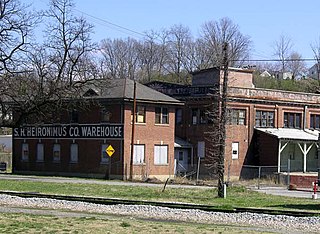
Virginia Can Company-S.H. Heironimus Warehouse is a historic factory and warehouse complex located at Roanoke, Virginia. The "U"-shaped complex was built in 1912, and consists of an office and two factory buildings. All three of the buildings are two stories in height and are constructed of brick on a raised foundation of poured concrete. A second-story pedestrian bridge connects the two factory buildings and a brick hyphen connects the office building to the north factory building. The complex was built for the Virginia Can Company, the first and largest manufacturer of tin cans in Roanoke, Virginia. After 1951, it housed a clothing factory and then the Heironimus department store warehouse.

C. W. Miller House, also known as the Mary Baldwin College Music Building, is a historic home located on the campus of Mary Baldwin University at Staunton, Virginia. It was built in 1899-1900, and is a 2 1/2-story, three bay, brick and stone building in a Châteauesque / Romanesque Revival style. It features four decorated brick chimneys with elaborately corbelled caps, a one-story wraparound porch, and a three-story round tower at the corner of the house. The house was sold to Mary Baldwin College in 1941 and houses the music school.

The Hermitage, also known as Devereaux House, is a historic home located at Virginia Beach, Virginia. The original section was built about 1700, with two later additions. It is a 1 1/2-story, four bay, Colonial era frame dwelling. The second portion was constructed by about 1820, doubling the size of the dwelling, and the final portion was added in 1940. Also on the property are three outbuildings, as well as a large subterranean brick cistern, now part of the basement to the house.

Winchester Coca-Cola Bottling Works is a historic Coca-Cola bottling plant located at Winchester, Virginia. It was built in 1940-1941, and is a two-story, reinforced concrete Art Deco style factory faced with brick. The asymmetrical four-bay façade features large plate-glass shop windows on the first floor that allowed the bottling operation to be viewed by the passing public. It has a one-story rear addition built in 1960, and a two-story warehouse added in 1974. Also on the property is a contributing one-story, brick storage building with a garage facility constructed in 1941. The facility closed in 2006.

























